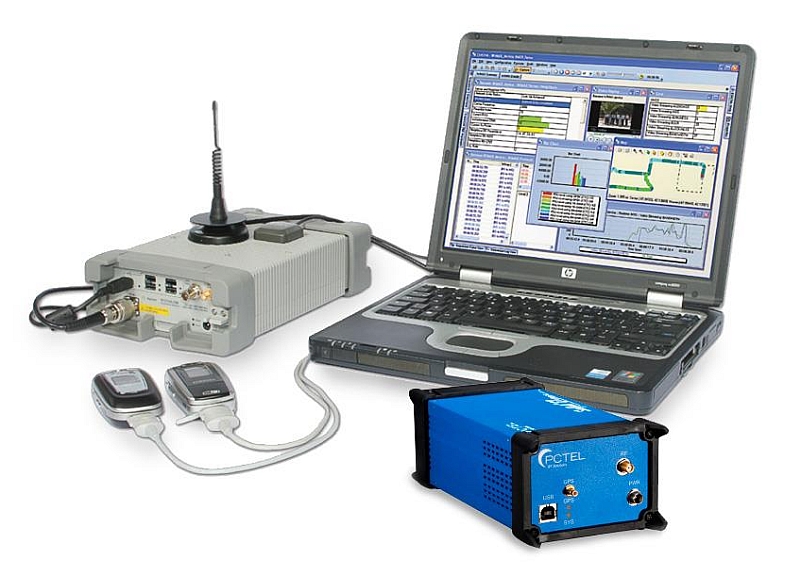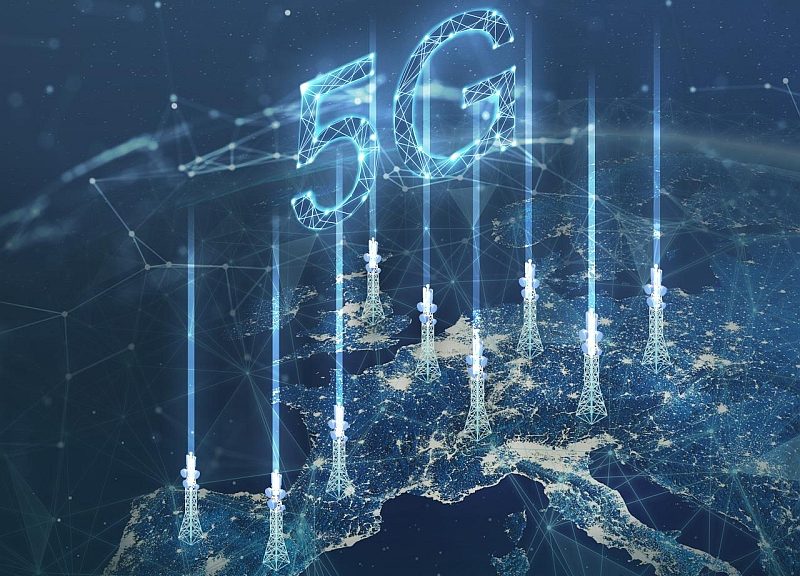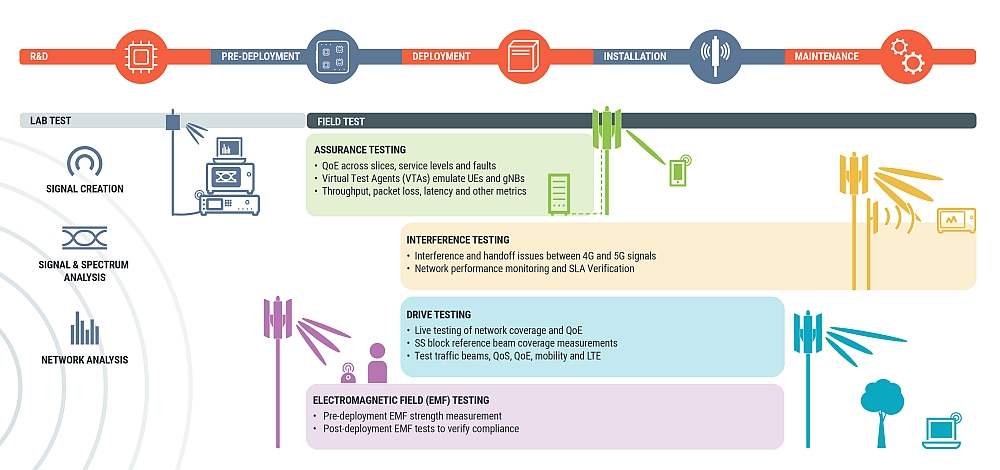- Fifth generation (5G) mobile communication networks are beginning to be deployed around the world. However, the commercial success of the services that 5G technologies promise will depend on two key factors: the quality of the user experience and the quality of these services.
- In the following article, Electro Rent examines new network testing strategies mandated by 5G technology. In particular, it discusses how these tests will differ from past practices and what new test equipment is needed for these purposes.
By Richard Martin, Product Manager, Electro Rent
The advent of 5G New Radio (NR) will bring major upheavals to the way in which the radio access network (RAN) is orchestrated. Because of the use of mmWave frequencies and orthogonal frequency division multiplexing (OFDM) waveforms, plus the emergence of advanced transmission methodologies, the air interface will be radically different from what was applicable in previous mobile communication generations. Consequently, performance parameters will be pushed way beyond what were possible before – in terms of the data rates delivered, the network capacity and the spectral efficiency. Eventually, this will have a huge influence on shortening latency times too (bringing them below 1ms). However, all this is destined to set unprecedented challenges for test engineers. One of the activities that is certain to go through significant alterations is drive testing.
5G’s Prospects in the Short/Medium Term
The Coronavirus outbreak has caused considerable disruption to the planned roll-out of 5G infrastructure over the course of 2020 There is now, however, growing impetus once again.
Although the GSMA has revised its forecast about how quickly initial 5G deployments will take hold, the organisation still appears to be confident that this technology will constitute 20% of all cellular connections by 2025. As 5G infrastructure begins to see more widespread implementation, it will be vital that data can be gathered about the coverage levels.
Drive Testing Fundamentals
Through drive testing, live data is acquired from various points within a network via equipment that is mounted to a vehicle of some form. This will generally comprise data logging/analysis hardware connected to an array of cellular handsets, plus a GPS receiver for accurately registering the vehicle’s location at any given time. Often all these items are built into a multi-channel scanner unit for added convenience. The vehicle employed when conducting a drive test could be a van or car. In some cases, a motorbike will be preferred – as this can prove a very effective way of negotiating congested city streets, and test work can thereby be completed in a quicker timeframe. Walking with handheld test devices may also be used to measure coverage within buildings and areas that can’t be reached by car or bike.
The data acquired during a drive test is used to check if predefined key performance indicators (KPIs) are actually being met (relating to both voice and data oriented services). By assuring adherence to these KPIs, the mobile network operator can safeguard against issues that might otherwise lead to subscriber frustration (such as poor signal, low data rates, dropped calls, lag in video streaming content, coverage blackspots, potential sources of interference, etc.). It is then possible to take action to address any problems that have been identified. The upshot of all this is that quality of service (QoS) and quality of experience (QoE) are not compromised and the risk of subscriber churn can be avoided.
Test Implications of Transitioning from 4G to 5G Infrastructure
Though the basic principles of drive testing are simple enough, the arrival of 5G means that the rules of the game have changed completely. Accurate evaluation of the network coverage that each base station in the network provides must be approached in an entirely different way to how it was in the 4G era.
There are modifications to the frequency bands allocated for this mobile generation – with frequencies going from sub-6GHz all the way up to mmWave (namely 24GHz and beyond). This is probably not going to prove that big an obstacle to overcome though. A far more sizeable challenge awaits – and this is due to the migration away from conventional, evenly spread cell-based coverage to one that relies on beamforming and complex multi-antenna configurations.
Prior to 5G, bases stations would transmit in all directions simultaneously. To boost performance, expand capacity and reduce power consumption figures, 5G will instead deal with numerous beams. Through multi-user MIMO (MU-MIMO), there will also be what is referred to as multi-path propagation. Together these innovations will make networks much more operationally effective and energy efficient than would be possible using the cell coverage topology that we are currently familiar with. It will mean that more bandwidth-intensive services can be supported and day-to-day running costs can be kept down.
Beamforming adds a whole new dimension to mobile coverage, with directionally oriented data links being established between the base station and user equipment. Drive tests will be done in relation to the synchronisation signal block (SSB) reference. The base station being tested will generate multiple SSB beams and the user equipment/scanner will connect to whichever is the strongest beam in its vicinity.

In situations where items of user equipment are in close proximity to one another, it will be necessary to ascertain whether adequate spatial separation can be maintained. This will mean that the respective beams will not interfere with another.
KPIs will be gauged in respect of the following parameters for the base station’s beams:
- The synchronisation signal reference signal received power (SS-RSRP) – which gives an estimate of the output power of the OFDM-modulated SSB beams emanating from the base station.
- The synchronisation signal reference signal received quality (SS-RSRQ) – that provides a measure of beam signal quality (taking noise into account) across the entire system bandwidth. If this figure is low at a given location, then handover to a neighbouring cell might be justified.
- The synchronisation signal signal-to-interference-plus-noise ratio (SS-SINR) – which is a ratio of a beam’s output signal power to what is coming from noise and any incident interference.The combination of ground level drive testing with tests that are conducted via aerial drones will allow the compiling of both horizontal and vertical data. This will lead to 3D renderings of the beam coverage from each base station. These are sure to prove of value when making decisions about how to optimise coverage at a given cell site.
Choice of 5G test solutions
A wide range of new solutions are available on the market to test the deployed networks from different aspects. It may be difficult to find your way around this plethoric offer. Accessing the new hardware and software needed can also be difficult, especially when budgets and capital resources are limited.
By working with Electro Rent, telecom operators and their technical partners can meet both of these challenges. They can access the latest equipment and software from leading manufacturers such as Infovista, PCTEL, Rohde & Schwarz, Keysight and Viavi, among others, and receive personalized support. With a choice of flexible rental solutions providing access to the latest network testing technologies, they are able to support any project or contract, even with the most demanding delivery requirements.








